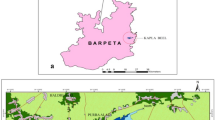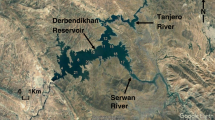Abstract
The physicochemical characteristics of water samples from selected boreholes in six peri-urban communities were analysed to assess the quality of waters for suitability for human consumption. Samples were collected from sixteen different boreholes at interval of 1 month from July to September 2015 and from December 2015 to February 2016 to cover rainy and dry seasons, respectively. Samples were analysed for temperature, pH, dissolved oxygen, biochemical oxygen demand, alkalinity, acidity, etc. using standard methods. The results were compared with World Health Organization standards. Data obtained for both rainy and dry seasons indicate pH ranges of 6.65–7.50 (mean value 7.09), temperature 27.00–29.00 °C (mean value 28.06 °C), dissolved oxygen 41.60–69.60 mg/l (mean value 49.53 mg/l), acidity 1.46–5.28 mg/l (mean value 3.16 mg/l), alkalinity 8.00–14.00 mg/l (mean value 10.82 mg/l), electrical conductivity 3.50–24.10 µS/cm (mean value 10.69 µS/cm), dissolved oxygen 41.60–69.60 mg/l (mean value 49.53 mg/l) and biochemical oxygen demand 8.00–33.60 mg/l (mean value 21.21 mg/l). Out of the 16 samples analysed, 12 were soft water while 4 were slightly hard water. Most of the physicochemical parameters, except dissolved oxygen and biochemical oxygen demand were within World Health Organization standard. The pollution index for physicochemical composition was mostly greater than 1, indicating heavy contamination of the waters. The results obtained in this study, especially biochemical oxygen demand and dissolved oxygen values, suggest that water from the boreholes sampled is not suitable for human consumption and may constitute a serious health risk to the consumers.





Similar content being viewed by others
References
Abbasi E, Khayatzadeh J (2010) The effects of heavy metals on aquatic animals. A paper presented at the 1st international applied geological congress, Islamic–Azad University Mashad-Branch, Iran, pp 26–28
Adekunle IM, Adetunji MT, Banjoko OB, Gbadebo AM (2007) Assessment of groundwater quality in a tropical rural settlement in southwest, Nigeria. Int J Environ Resour Publ Health 4(4):307–318
Adeyemi O, Oladiji AT, Oloyede OB (2007) Physicochemical and microbial characteristics of leachate contaminated groundwater. Asian J Biochem 2(5):343–348
Agbaire PO, Oyibo PI (2009) Seasonal variation of some physicochemical properties of borehole water in Abraka, Nigeria. Afr J Pure Appl Chem 3(6):116–118
Akpabio JJ, Ekpo FE (2013) Physicochemical and heavy metals quality assessment of borehole water in different residential areas of uyo metropolis. A case study of G.R.A and low income residential areas. Int J Sci Res 4(2):37–44
Akpoveta OV, Okoh BE, Osakwe SA (2011) Quality assessment of borehole water used in the vicinities of benin, Edo State and Agbor, Delta State of Nigeria. Curr Res Chem 3(1):62–69
Akubugwo EI, Ude VC, Ugbogu OI, Uhuegbu FO (2012) Physicochemical properties and heavy metal content of selected water sources in Ishiagu Ebonyi State, Nigeria. J Biodivs Environ Sci 2(2):21–27
Ali I, Aboul- Enein HY (2006) Instrumental methods in metal ion speciation: chromatography, capillary electrophoresis and electrochemistry. Taylor & Francis Ltd., New York, p 376
Ali I, Jain CK (2004) Advances in arsenic speciation techniques. Int J Environ Anal Chem 84(12):947–964
Ali I, Aboul- Enein HY, Gupta VK (2009) Nano chromatography and capillary electrophoresis: pharmaceutical and environmental analysis. Wiley, Hoboken, pp 49–52
Ali I, Gupta VK, Khan TA, Asim M (2012) Removal of arsenate from aqueous solution by electro-coagulation method using Al–Fe electrodes. Int J Electrochem Sci 7:1898–1907
Ali I, Alothman ZA, Alwarthan A, Asim M, Khan AT (2014) Removal of arsenic species from water by batch and column operations on bagasse fly ash. J Environ Sci Pollut Res 21(5):3218–3229
Ali I, Alothman ZA, Sanagi MM (2015) Green synthesis of iron nano impregnated adsorbent for fast removal of fluoride from water. J Mol Liq 211:457–465
Ali I, Alothman ZA, Alharbi OML (2016a) Uptake of pantoprazole drug residue from water using novel synthesized composite iron nano adsorbent. J Mol Liq 218:465–472
Ali I, Alothman ZA, Alwarthan A (2016b) Green synthesis of functionalized iron nano particles and molecular liquid phase adsorption of ametryn from water. J Mol Liq 221:1168–1174
Ali I, Alothman ZA, Alwarthan A (2016c) Molecular uptake of congo red dye from water on iron composite nano particles. J Mol Liq 224:171–176
Ali I, Alothman ZA, Alwarthan A (2016d) Removal of secbumeton herbicide from water on composite nano adsorbent. Desalination Water Treat 57(22):10409–10421
Ali I, Alothman ZA, Alwarthan A (2016e) Sorption, kinetics and thermodynamic studies of Atrazine herbicide removal from water using iron nano composite material. J Environ Sci Technol 13:733–742
Ali I, Alothman ZA, Alwarthan A (2016f) Synthesis of composite iron nano adsorbent and removal of ibuprofen drug residue from water. J Mol Liq 219:858–864
Ali I, Alothman ZA, Alwarthan A (2017a) Uptake of propranolol on ionic liquid iron nano composite adsorbent: kinetic, thermodynamics and mechanism of adsorption. J Mol Liq 236:205–213
Ali I, Alothman ZA, Alwarthan A (2017b) Supra molecular mechanism of the removal of 17-B-estradiol endocrine disturbing pollution from water on functionalized iron nano particle. J Mol Liq 441:123–129
Ali I, Alharbi OML, Alothman ZA, Badjah AY, Basheer AA (2018) Artificial neural network modeling of amido black dye sorption on iron composite nano material: kinetics and thermodynamics studies. J Mol Liq 250:1–8
American Public Health Association (APHA) (1980) Methods for the examination of water and waste water, 5th edn. Washington, pp 182–256
American Public Health Association (APHA) (1998) Standard method for examination of water and waste water, 20th edn. New York, pp 193–199
American Society for Testing and Materials (ASTM) (1978) Annual book of ASTM standard for water. ASTM: Part 31, pp 310–318
Asfaram A, Ghaedi M, Agarwal S, Tyagi I, Gupta VK (2015) Removal of basic dye Auramine- O by ZnS: Cu nanoparticles loaded on activated carbon: optimization of parameters using response surface methodology with central composite design. J R Soc Chem Adv 5(24):18438–18450
Association Official Analytical Chemists (AOAC) (1980) Official methods for analysis of the AOAC, 13th edn. AOAC, Washington, pp 554–555
Balch RT (1981) Measurement of turbidity with a spectrophotometer. Ind Eng Chem Anal 3(2):124–128
Basheer AA (2018) Chemical chiral pollution: impact on the society and science and need of the regulations in the 21th century. Chirality 30(4):402–406
Boominathan RA, Khan SM (1994) Effect of distillery effluents on pH, dissolved oxygen and phosphate content in Uyakundan channel water. Environ Ecol 12(4):850–853
Burakova EA, Ali I, Dyachkova TP, Rukhov AV, Tugolukov EN (2018) Novel and economic method of carbon nano tubes synthesis on a nickel magnesium oxide catalyst using microwave radiation. J Mol Liq 253:340–346
Chukwu GU (2008) Water quality assessment of borehole in Umuahia south local government area of Abia State, Nigeria. Pac J Sci Technol 9(2):592–598
Dastkhoon M, Ghaedi M, Asfaram A, Goudarzi A, Gupta VK (2015) Ultra sound assisted adsorption of malachite green dye onto ZnS: Cu–NP–AC: equilibrium isotherms and kinetics studies-response surface optimization. Sep Purif Technol 156:780–788
Dehghani MH, Sanaei D, Ali I, Bhatnagar A (2016) Removal of chromium(vi) from aqueous solution using treated waste water newspaper as a low-cost adsorbent: kinetic modeling and Isotherm studies. J Mol Liq 215:671–679
Essandoh M, Wolgemuth D, Pittman CU, Mohan D, Mlsna T (2017a) Phenoxy herbicide removal from aqueous solutions using fast pyrolysis switch grass bio char. Chemosphere 174:49–57
Essandoh M, Wolgemuth D, Pittman CU, Mohan D, Mlsna T (2017b) Adsorption of metribuzin from aqueous solution using magnetic and non-magnetic sustainable low-cost bio char adsorbents. Environ Sci Pollut Res 24(5):4577–4590
Ezelioha NC, Ojiako EN, Orakwue FC (2011) Physicochemical studies and bacteriological assay of rural water resources (Boreholes) in Unubi, Nnewi—South Local Government Area of Anambra State, Nigeria. Anachem J 5(1):964–968
Girl SI, Singh AK (2015) Human health risk and ecological risk assessment of metals in fishes, shrimps and sediments from a tropical river. Int J Environ Sci Technol 12:2349–2362
Gupta VK, Ali I (2012) Environmental water: advances in treatment, remediation and recycling. Elsevier, Amsterdam, pp 29–212
Gupta VK, Tyagi I, Agarwal S, Sadegh H (2015) Experimental study of surfaces of hydrogen polymers HEMA, HEMA-EEMA-MA and PVA as adsorbent for removal of azo dyes from liquid phase. J Mol Liq 206:129–136
Igwilo IO, Maduabuchi UJ, Orisakwe OE (2006) Toxicological study of the Anam River in Otuocha, Anambra State, Nigeria. Archit Environ Occup Health 61(5):205–208
Karanth KR (1994) Groundwater assessment development and management. Tata McGraw-Hill Publishing Company Limited, New Delhi, pp 75–79
Kemppainen BW, Lenz SD, Mchel-Henney WH, Renden JA, Vodela JK (1997) Drinking water contaminants. Poult Sci 76:1474–1492
Khan TA, Sharma S, Ali I (2011) Adsorption of rhodamine B dye from aqueous solution onto acid activated mango (magnifera indica) leaf powder: equilibrium, kinetic and thermodynamic studies. J Toxicol Environ Health Sci 3:286–297
Khan AE, Khan AT, Mukhlif AA (2012) Uptake of Cu2+ and Zn2+ from simulated waste water. Using muskmelon peel bio char: isotherm and kinetic studies. Environ Sci Pollut Res 19:1668–1676
Lokhande RS, Singare PU, Pimple DS (2011) Toxicity study of heavy metals pollutants in waste water effluent samples collected from Taloja industrial estate of Mumbai, India. Res Environ 1:3–19
Mosley LM, Singh SI (2003) Trace metal levels in drinking water of Viti Levu, Fiji Islands. Spec Pac J Nat Sci 21:31–34
Nekouei F, Nekouei S, Tyagi I, Gupta VK (2015) Kinetic thermodynamic and isotherm studies for acid blue 129 removal from liquid using copper oxide nanoparticle—modified activated carbon as a novel adsorbent. J Mol Liq 201:124–133
Nikfar E, Dehghani MH, Mahvi AH, Rastkari N, Gupta VK (2016) Removal of Bisphenol A from aqueous solutions using ultrasonic waves and hydrogen peroxide. J Mol Liq 213:332–338
Obi CN, Okocha CO (2007) Microbiological and physicochemical analysis of selected borehole water in world bank housing Estate Umuahia Abia State, Nigeria. J Eng Appl Sci 2(5):920–929
Okoye AC, Okoye CO (2008) Urban domestic solid waste management. Rex Charles and Patrick Limited Nimo, Anambra State, pp 5–7
Onwughara NI, Ajiwe VIE, Nnabuenyi HO (2013) Physicochemical studies of water from selected boreholes in Umuahia North local government area of Abia State, Nigeria. Int J Pure Appl Biosci 1(3):34–44
Pearce F (2006) When the rivers run dry: water—the defining crisis of the twenty-first century. Beacon Press, Boston, pp 88–89
Robati D, Mirza B, Rajabi M, Mordi O, Gupta VK (2016) Removal of hazardous dyes basic Red 12 and methyl orange using graphene oxide as an adsorbent from aqueous phase. Chem Eng J 284:687–697
World Health Organisation (WHO) (1993) Guidelines for drinking water quality. Revision of the 1984 guideline. Final Task Group Meeting, Geneva, pp 21–25
World Health Organisation (WHO) (2004) Water sanitation and health programme. Managing water in the home: accelerated health gains from improved water sources, pp 112–125
World Health Organisation (WHO) (2006) Guidelines for drinking water quality, first addendum to 3rd ed. Recommendations, Geneva, pp 105–110
World Health Organisation (WHO); United Nation Children Fund (UNICEF) (2012) Progress on drinking water and sanitation WHO, Geneva and UNICEF, New York, pp 122–125
Acknowledgments
The authors wish to thank all who assisted in conducting this work.
Author information
Authors and Affiliations
Corresponding author
Ethics declarations
Conflict of interest
The authors declare that there is no conflict of interest in any manner concerning the research that gave rise to the data herein discussed and published.
Additional information
Editorial responsibility: V. K. Gupta.
Rights and permissions
About this article
Cite this article
Eboagu, N.C., Ajiwe, V.E. & Odidika, C.C. Physicochemical parameters of water from selected boreholes utilized as potable water. Int. J. Environ. Sci. Technol. 16, 3605–3614 (2019). https://doi.org/10.1007/s13762-018-1931-4
Received:
Revised:
Accepted:
Published:
Issue Date:
DOI: https://doi.org/10.1007/s13762-018-1931-4




